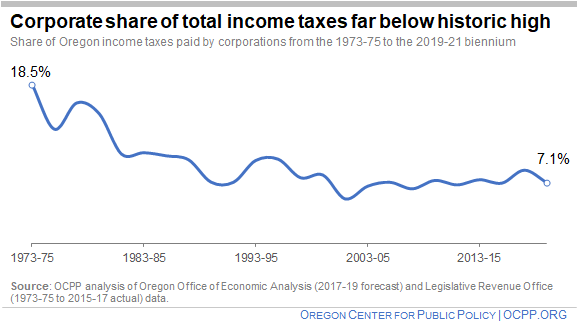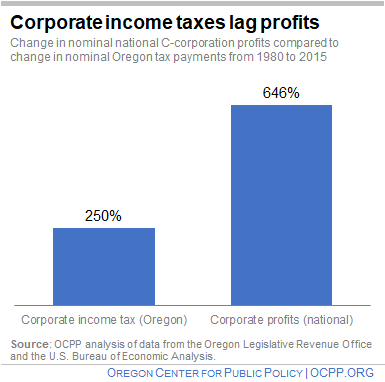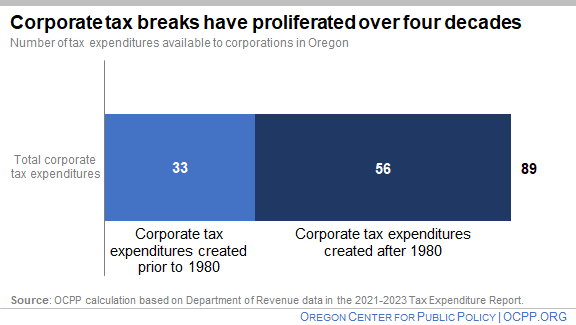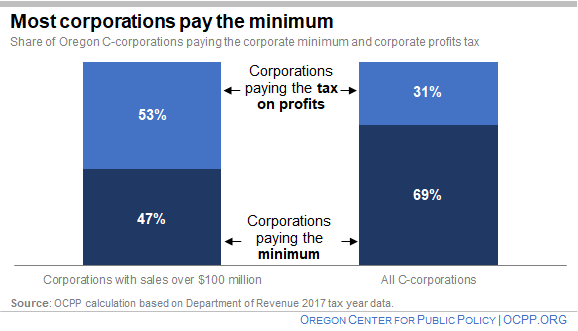Download a PDF of Corporate Tax Transparency is Right for Oregon
Executive Summary
Oregon can take an essential step to fix the widespread problem of corporate tax avoidance by enacting corporate tax transparency. Transparency means requiring corporations to make public how much they pay in Oregon income taxes, as well as enough information to understand what benefits Oregonians get from the many tax loopholes and subsidies that corporations exploit.
At a time of healthy corporate profits, the tax on those profits — the corporate income tax — has failed to keep up. The share of Oregon income taxes paid by corporations has declined by more than 60 percent since the mid-1970s. Also, from 1980 to 2015, corporate income tax collections in Oregon increased 250 percent, while corporate profits nationally grew 646 percent, without adjusting either figure for inflation.
There is ample evidence of widespread corporate tax avoidance. It’s well-established that corporations have lobbied for and won tax breaks, shifted profits abroad to avoid Oregon taxes, and that about seven in 10 corporations — including many of the largest corporations — pay the bare minimum in Oregon corporate taxes.
Corporate tax transparency would increase accountability and fairness in Oregon’s tax system. Specifically, corporate tax transparency would:
- Shine a light on how corporations avoid paying taxes, allowing the public and lawmakers to determine whether reforms to the corporate income tax system are needed.
- Discourage corporate tax avoidance.
- Clarify what Oregonians get in return for corporate tax breaks.
- Enable policymakers to evaluate corporate claims about the impact of proposed tax changes.
That’s why the Oregon legislature should adopt the Corporate Tax Transparency Act. The Act would only require disclosure from corporations that meet three conditions: They operate in multiple states; they are publicly-traded, such as on a stock exchange; and they benefit from a tax expenditure.
Enacting corporate tax transparency would increase accountability and tax fairness — a win for Oregonians.
Introduction
Oregon can take an essential step to fix the widespread problem of corporate tax avoidance by enacting corporate tax transparency. Transparency means requiring corporations to make public how much they pay in Oregon income taxes, as well as enough information to understand what benefits Oregonians get from the many tax loopholes and subsidies that corporations exploit.
Oregonians pay the price when corporations shed their tax responsibilities. When corporations avoid taxes, it means either the state has fewer resources to fund schools and other essential public services, or families must pay more in taxes to make up the difference — or a combination of both.
There is ample evidence that corporations have been avoiding their tax responsibilities. At a time of healthy corporate profits, the tax on those profits — the corporate income tax — has failed to keep up.[1] The share of Oregon income taxes paid by corporations has declined by more than 60 percent since the mid-1970s. Other measures also reveal the weakening of the corporate income tax over the past few decades. Some of the decline is the result of corporations artificially shifting profits overseas to avoid paying taxes and exploiting tax loopholes and subsidies.[2]
The lack of public accountability makes it easier for corporations to avoid taxation. While it’s clear that some corporations engage in aggressive tax avoidance, the identity of those corporations is unclear, as are the precise mechanisms they use to avoid taxes. Oregon does not require corporations to make public how much they pay in income taxes or how they arrive at that figure. As such, Oregonians are in the dark as to which corporations fail to uphold their responsibilities toward the common good. Oregonians also do not know which corporations use which tax subsidies, and what Oregon gets in return for those subsidies. Ultimately, the lack of transparency enables aggressive corporate tax avoidance to go unchallenged.
That’s why the Oregon legislature should adopt the Corporate Tax Transparency Act. The Act would only require disclosure from corporations that meet three conditions: They operate in multiple states; they are publicly-traded, such as on a stock exchange; and they benefit from a tax expenditure. Enacting corporate tax transparency would increase accountability and tax fairness — a win for Oregonians.[3]
Corporate income tax has weakened, even as profits have been strong
Oregon’s corporate income tax — a tax on corporate profits — carries less weight now than it did more than four decades ago. This relative decline has happened at a time when corporate profits have been strong.
Measured as a share of all income taxes collected by the State of Oregon, the corporate income tax today is but a fraction of what it used to be. In the mid-1970’s, corporations paid 18.5 percent of all income taxes. In the current budget period (2019 – 2021), by contrast, corporate income taxes are only expected to make up 7.1 percent (about one in every 14 dollars) of all income taxes. This leaves the families who pay the personal income tax to make up the difference.

Another way of measuring the weakening of the corporate income tax is to consider how much revenue it generates relative to the size of Oregon’s economy. In the 1973-75 budget period, corporate income tax collections added up to 0.55 percent of Oregon’s economy. But since the turn of the century, this measure has averaged 0.25 percent. The most recent reading, for the 2017-19 budget period, stood at 0.36 percent.[4]
This relative decline of the corporate income tax has occurred despite an environment of strong corporate profits. Since the Great Recession, for instance, national corporate profits as a share of national income have hovered at or near a record high of 7 percent.[5] Indeed, it is clear that the corporate income tax has failed to keep up with corporate profits. From 1980 to 2015, corporate income tax collections in Oregon increased 250 percent. Over the same period, corporate profits nationally grew 646 percent. Neither figure is adjusted for inflation.

These calculations don’t factor in the impact of the 2017 Tax Cuts and Jobs Act, a federal tax reform package that included permanent tax cuts for corporations.[6]Because Oregon’s tax code connects automatically to the federal tax code, some of the tax cuts for corporations have become part of Oregon law.[7]
Corporate tax avoidance is widespread
The weakening of the corporate income tax is in part the result of aggressive tax avoidance schemes. “Tax avoidance” refers to legal means by which corporations minimize their tax bills, as opposed to “tax evasion,” which refers to illegal means. Two common forms of tax avoidance are the shifting of profits to overseas tax havens and the use of tax loopholes and subsidies.
Rise of pass-through businesses only partially explains decline of corporate income tax
Another factor driving the relative decline of the corporate income tax is the growing share of businesses taking corporate forms not subject to the corporate income tax.[8] Businesses that in the past would have incorporated as C-corporations, which pay the corporate income tax, now might incorporate as S-corporations or partnerships, which don’t pay the tax. The rise of these new corporate forms, however, only explains part of the decline. As shown above, the profits accruing to C-corporations have far outpaced the income taxes paid by C-corporations.
The following are all well-established facts:
Corporations have lobbied for and won lots of tax breaks
The number of tax breaks benefiting corporations have exploded over the past decades. Today, corporations can claim 89 “tax expenditures,” the official name for what are commonly referred to as “tax breaks,” “tax loopholes,” or “tax subsidies.”[9]Half of all tax expenditures were created by the Oregon legislature, while the other half originated in Congress (see below). Of the 89 existing tax expenditures, only 33 existed prior to 1980.[10] While some tax expenditures are well-designed to achieve an important public policy goal, many others drain resources that could be used to help Oregonians afford housing, child care, and other essentials.[11]

Some of these tax breaks are due to the efforts of corporate lobbying of Congress. Oregon’s tax code follows the federal definition of “taxable income,” so when Congress passes a new corporate tax break that alters that definition, Oregon often replicates that tax break. The only way to stop that tax break from taking effect is for the Oregon legislature to vote affirmatively to reject it, which it often fails to do. An example of this is how Oregon automatically replicated the three tax breaks included in the flawed federal tax policy known as “Opportunity Zones.”[12] The Oregon legislature was considering disconnecting from this tax break until a Republican walkout ground the 2020 session to a halt.[13]
Big corporations shift profits abroad to avoid Oregon taxes
Big corporations avoid taxes by artificially shifting profits overseas.[14] The particular mechanisms for avoiding taxes vary, but the basic strategy is the same: reduce taxable profits in the place they were actually earned and instead report them in a place that levies little or no taxes on corporate income, such as the Cayman Islands.[15] Because this strategy requires having subsidiaries operating abroad, the offshoring of corporate profits is a game played exclusively by large, multinational corporations.
For instance, Oregon-based Nike, Inc., reportedly shifted $12.2 billion in earnings to offshore tax havens over a six-year period, allowing the company to shrink its effective tax rate at a time when the company saw rising sales and profits.[16] Filings with the Securities and Exchange Commission show that Nike owns dozens of subsidiaries in some of the leading offshore tax havens.[17] Other corporations with a significant presence in Oregon — Intel, Columbia Sportswear, and Precisions Castparts — also have subsidiaries in well-known tax havens.[18]
About seven in 10 corporations pay the bare minimum
The most recent figures by the Oregon Department of Revenue show that 69 percent of all corporations required to pay Oregon taxes pay the minimum tax (the minimum amounts to 0.15 percent or less of their sales in Oregon).[19] This included many of the biggest corporations. Nearly half of corporations with more than $100 million in Oregon sales paid the minimum.[20] Due to the lack of corporate tax transparency, lawmakers do not know how these corporations drove their taxable income into the ground, nor the identity of profitable corporations paying less than a tenth of a penny for each dollar of sales.

Oregonians need transparency to fix the problem of corporate tax avoidance
Corporations have rigged the tax system; corporate tax transparency is a crucial tool to fix it.
The Corporate Tax Transparency Act requires corporations to make public certain tax and financial information by filing a disclosure with the Oregon Secretary of State. The Act would apply to C-corporations that do business in multiple states and are publicly traded, meaning they are listed on a stock exchange like the New York Stock Exchange or an over-the-counter market. This explicitly excludes pass-through businesses (partnerships, limited liability corporations, S-corporations, and sole proprietorships) and any C-corporations that only do business in Oregon. Among corporations subject to the Act, only those that use a tax expenditure (credit, deduction, adjustment, etc.) would be required to disclose.
These businesses would disclose information such as their Oregon sales, Oregon property and income taxes paid, and tax breaks used.[21] Specific information outlining the tax breaks a company uses and the amount their taxes are reduced thanks to each tax break will help legislators evaluate the effectiveness of these corporate tax subsidies. (See Appendix for more information on the Corporate Tax Transparency Act.)
Corporate tax transparency would be a win for Oregonians, increasing accountability and fairness in Oregon’s tax system. Specifically, corporate tax transparency would:
- Shine a light on how corporations avoid paying taxes. While the evidence indicates that corporate tax avoidance is common, the specifics of how they each avoid taxation is often unclear. Corporate tax transparency would reveal those specifics. The information would help the public and lawmakers determine whether reforms to the corporate income tax system are needed.
- Discourage corporate tax avoidance. Corporate tax disclosure may dissuade some corporations from engaging in aggressive tax avoidance schemes, knowing that key tax information will become public. Such information would at least allow Oregon consumers to “vote with their dollars” — choosing to do business with corporations they view as supporting the common good.
- Clarify what Oregonians get in return for corporate tax breaks. Oregon has enacted many tax programs intended to create jobs or incentivize investment in the state. Corporate tax transparency would show which corporations are using which tax incentives, and how much each incentive is costing the state. This would enable policymakers to determine whether these tax incentive programs are worth their cost.
- Enable policymakers to evaluate corporate claims about the impact of proposed tax changes. When lawmakers consider changes in corporate tax policy, lobbyists for specific corporations often claim that these will increase their companies’ tax payments enormously. Corporate tax transparency will enable policymakers to evaluate the validity of such claims.
Conclusion
Corporations have rigged the tax system to their advantage. Shining a light on the corporate tax system would allow Oregonians to see which corporations pay the bare minimum in income taxes, while reporting big profits to shareholders. It will allow Oregonians to see which corporations exploit what tax loopholes and subsidies, and which might be shifting profits overseas to avoid taxes on profits earned in Oregon. In short, corporate tax transparency is essential to make the corporate income tax system work for the benefit of all Oregonians.
Appendix 1: Policy details
Who is required to provide information?
- Only C-corporations (and their subsidiaries) that meet all of the following conditions:
- Are publicly traded.
- Do business in Oregon, not just those that file a corporate income tax/excise tax return.
- Sell in states/nations other than Oregon.
- Use tax expenditures of any kind, not just tax credits, and including Net Operating Loss deductions.
How is the information disclosed?
- Information is reported directly to the Secretary of State’s office, which then makes make the information available in a searchable and exportable online database.
What is the process for ensuring accuracy?
- The forms can be audited.
- Failing to file or filing an inaccurate statement results in a penalty and public disclosure of failure.
- The penalties are assessed on the corporation and its Chief Operating Officer, who signs off on accuracy.
What is the penalty for noncompliance?
- The penalty equals 0.25% of the corporation’s gross receipts in Oregon (up to a maximum penalty of $1 million per year) for failure to comply and public disclosure.
What information is disclosed?
- More specifics will be available once legislative language is finalized, but the policy is expected to include:
- General: Name of the corporation and any subsidiaries owned by the corporation, total wages and compensation in Oregon.
- Corporate income and excise tax: Total Oregon sales, taxable income, tax paid, tax expenditures used (individually enumerated).
- Property: Total assessed and real market value of property owned in Oregon, total amount paid to each taxing jurisdiction, and property tax expenditures (individually enumerated).
When is the information disclosed?
- The information would be disclosed starting in 2022, when information on the financial activities occurring in 2020 would be reported, providing a two year delay.
Endnotes
[1] This paper uses corporate income tax to refer to both the corporate excise tax and corporate income tax. Unless otherwise noted, “corporations” or “corporate” refers to C-corporations.
[2] Tyler Mac Innis and Juan Carlos Ordonez, The Gaming and Decline of Oregon Corporate Taxes, Oregon Center for Public Policy, June 2016, and Daniel Hauser, “Trump tax plan showers rich Oregonians with tax cuts,” Oregon Center for Public Policy, October 2017.
[3] Michael Mazerov, State Corporate Tax Disclosure, Center on Budget and Policy Priorities, February 2007, and Daniel Morris, The Need for Corporate Tax Transparency in Oregon, November 2017.
[4] Data from the U.S. Bureau of Economic Analysis, Gross State Product, and the Oregon Legislative Revenue Office, 2020 Oregon Public Finance: Basic Facts.
[5] National profits data is used because data is unavailable for C-corporation profits from activity in Oregon. Figures for profits are profits after tax with inventory valuation adjustment and capital consumption from the U.S. Bureau of Economic Analysis’ data on national income multiplied by the ratio of U.S. Internal Revenue Service data on the share of all corporate profits accruing to C-corporations in that same year. Corporate tax payment data is from the Oregon Legislative Revenue Office, 2020 Oregon Public Finance: Basic Facts. Using national profits data is an incomplete means of conveying relevant profits in Oregon, because Oregon’s corporate tax base does not perfectly match that of the nation. However, the data is still a helpful approximation to understand the trends underpinning corporate taxation.
[6] Chuck Marr, Brendan Duke, and Chye-Ching Huang, New Tax Law Is Fundamentally Flawed and Will Require Basic Restructuring, Center on Budget and Policy Priorities, August 2018, and Daniel Hauser, “Trump tax plan showers rich Oregonians with tax cuts,” Oregon Center for Public Policy, October 2017.
[7] Daniel Hauser, “Ditch the federal tax scheme – or blow a hole in Oregon’s budget,” Oregon Center for Public Policy, February 2018.
[8] Aaron Krupkin and Adam Looney, “9 facts about pass-through businesses,”Brookings Institution, May 2017.
[9] OCPP calculations based on the Oregon Department of Revenue, 2019-2021 Tax Expenditure Report. All expenditures where a corporation could or do benefit in the 2021-2023 biennium are included. Sometimes this includes expenditures that have sunset but still incur costs to the state.
[10] Ibid.
[11] The Earned Income Tax Credit is one example of a positive and helpful tax expenditure. Juan Carlos Ordonez, “Boost the EITC, improve social and economic circumstances for Oregon children,” Statesman Journal, June 7, 2019.
[12] Daniel Hauser and Juan Carlos Ordonez, “4 ways ‘Opportunity Zones’ squelch real opportunity,” Oregon Center for Public Policy, April 2019.
[13] House Bill 4010 (2020 session).
[14] Daniel Hauser, Oregon Can Raise $376 Million by Clamping Down on Offshore Corporate Tax Avoidance, Oregon Center for Public Policy, November 2018.
[15] The Cayman Islands were recently identified as one of the United States most costly tax havens. Analysis available at https://iff.taxjustice.net/#/profile/USA.
[16] Jeff Manning, “Profits double, tax payments fall at Nike, drawing the attention of EU regulators,” The Oregonian, January 12, 2019.
[17] Michael Mazerov, “Oregon Should Reinstate Its Tax Haven Law,” Center on Budget and Policy Priorities, June 2018.
[18] Ibid.
[19] OCPP analysis of data from the Oregon Department of Revenue, Oregon Corporate Excise and Income Tax: Characteristics of Corporate Taxpayers, 2019 Edition.
[20]Ibid.
[21] The Act would not include information from the new Corporate Activity Tax because the tax was developed to limit tax expenditures and relatively few currently exist.






